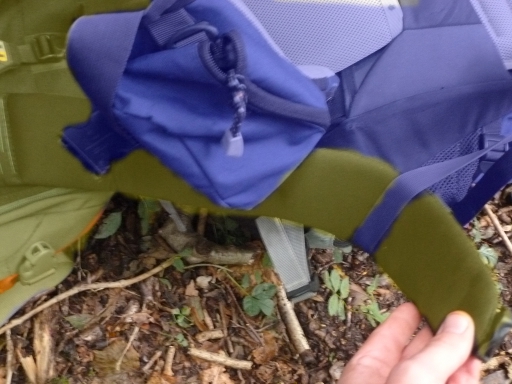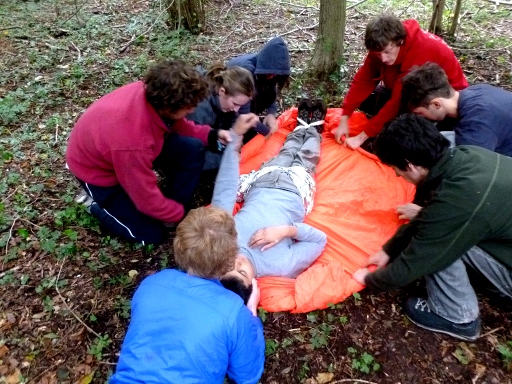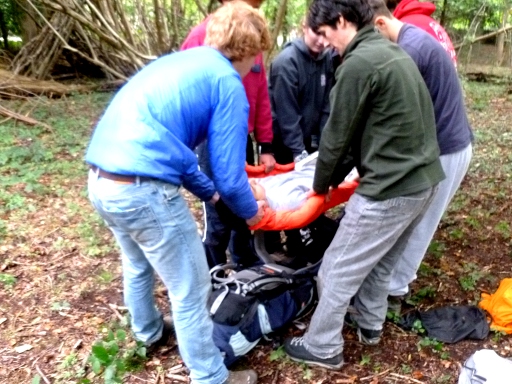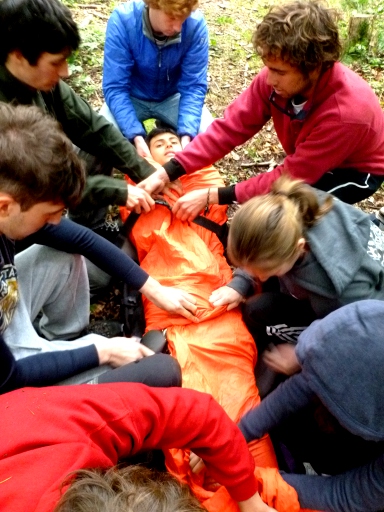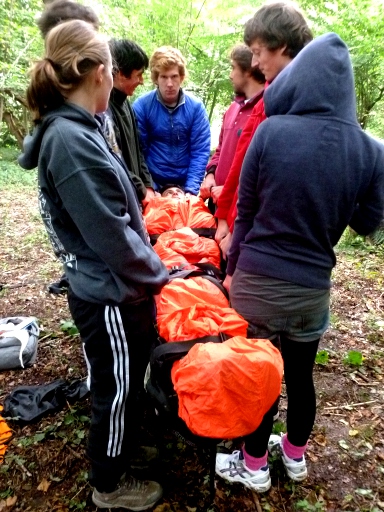An Improvised Stretcher
Before we get carried away with big ideas of fashioning an improvised stretcher from 100 yards of stout cordage with the intention of moving your casualty many miles over hill or dale, think:
Do you need to move your casualty?
As a rule we only move casualties if we have to. The most import reason is to save lives.
At a basic level of training or if no alternative is available we will tilt a casualty's head back to open an airway even if this may pose a potential risk to the spine because an open airway is an absolute priority.
An unconscious casualty may have an airway held open but this will not prevent fluids from building up and choking the casualty so, at a basic level and if no alternative exists we will roll the casualty into the Safe Airway Position even at the expense of comfort or aggravating minor injuries because there is clear need.
If a casualty were in a burning vehicle or lying in the path of a rock fall we may (after ensuring our safety and the safety of others) quickly move the casualty, dragging if need be, to safety, regardless of injury.
So, again, do you need to move your casualty?
Moving casualties, even with a dedicated stretcher is tiring. Tired rescuers are susceptible to injury and more susceptible to heat stroke or hypothermia. Is it worth the risk?
It is impossible, even with a dedicated stretcher, to move a casualty without causing movement and movement can cause pain and/or further damage.
In reality, moving a casualty requires a coordinated effort of many, many volunteers over even a very short distance. How far are you going to realistically move your casualty?
So what would be a justification for moving a casualty by stretcher?
Investing the time to fabricate a stretcher would infer the situation is not necessarily time critical, where a drag would be more appropriate, so we are looking at extended care.
Moving the casualty may be justified in order to move the casualty from an awkward, unstable or exposed location, a short distance to somewhere sheltered, protected or more stable. Somewhere more conducive to managing a group together.
The most care is warranted for a potential spine or pelvic injury where body movement should be limited as much as possible. Any movement of the casualty will require a controlled, considered approach which will benefit from an investment in time in order to prepare lifting / moving equipment. If we have taken the decision to mover the casualty, we want to do it as carefully and as best we can.
The Rucksack Stretcher
This is not the definitive improvised stretcher although it has several real advantages.
The waist straps secure the casualty to the stretcher.
The shoulder straps are infinitely more more comfortable to carry than hand-fulls of sheets or rope.
When the casualty is lowered during rests or into the final position, the rucksacks provide protection from the ground and insulate from the cold.
Disadvantages:
You need a minimum of three expedition (60Ltr+) rucksacks. Four 40-50Ltr rucksacks can be used but this increases the number of articulations, reducing the rigidity of the stretcher.
With the casualty positioned, the stretcher is 'top heavy'. Be aware of leaving the casualty as they may roll.
There is no perfect stretcher - we can only do the best we can with what we have as long as it is an appropriate decision to do so.
Instructions
Equipment needed:
3 x 60Ltr Rucksacks
Foil blanket
Tape or bandage for ankles
Sheet, flysheet or tarp
SAM splint if available
Preparing the casualty
Maintaining spinal immobilization of the casualty, stabilise the pelvis as following these guidelines.
If a spinal collar is not available, an improvised collar can be made using a SAM Splint. In either case, application of a collar DOES NOT remove the need for manual stabilisation of the casualty.
Using the Log Roll technique (to be discussed in a forthcoming article) roll the casualty carefully onto one side. Where possible offer the choice of side to the person at the head for their comfort and convenience.
Another person, outside of the Log Roll team, opens up the sheet and 'concertinas' pleats of material in their hand with arms wide apart.
Constructing the Stretcher
Completely undo the shoulder straps of the middle rucksack.
Link the open shoulder straps through the shoulder straps of the rucksacks above and below and do the buckles back up to 'daisy chain' all three pairs of shoulder straps together.
Reinforce the stability of the stretcher by passing walking poles, skis, tent poles etc through the side compression straps, if available.
Undo the waist straps to their full extent in readiness for the casualty.
Packaging the casualty
Lower the casualty back onto the sheet. The pleat can now be unfurled from underneath the casualty. The casualty should now be more or less in the middle of the sheet.
Pull all of the creases out and ensure it is taut underneath the casualty. Any creases or pleats left in the sheet will unfold when you attempt to lift the casualty.
Ensure the casualty's head is not on top of the sheet - the sheet should extend from the casualty's shoulders down to their feet. Despite our best intentions, the lifting sheet will 'hammock', bending the casualty's neck. As such the head and neck are supported almost independently of the body which is being lifted. The person at the head (you!) works hard to maintain spinal alignment.
Using a a minimum of four volunteer, but ideally six, roll the edges of the sheet in close to the body of the casualty; the closer the better as this will help control movement when lifting.
At your command, everyone lifts the casualty and positions them on the stretcher.
Unroll the edges and wrap the casualty in the sheet to insulate the casualty from the cold. Diagnostic equipment should be taped in place with the displays on the outside of the cocoon to avoid exposing the casualty to check vital signs.
Use the waist straps of the rucksacks to secure the casualty to the improvised stretcher.
The casualty can now safely be moved safely, comfortable, with increased confidence of reduced spinal movement, protection from the elements and with consideration to the rescuers' comfort and safety.



